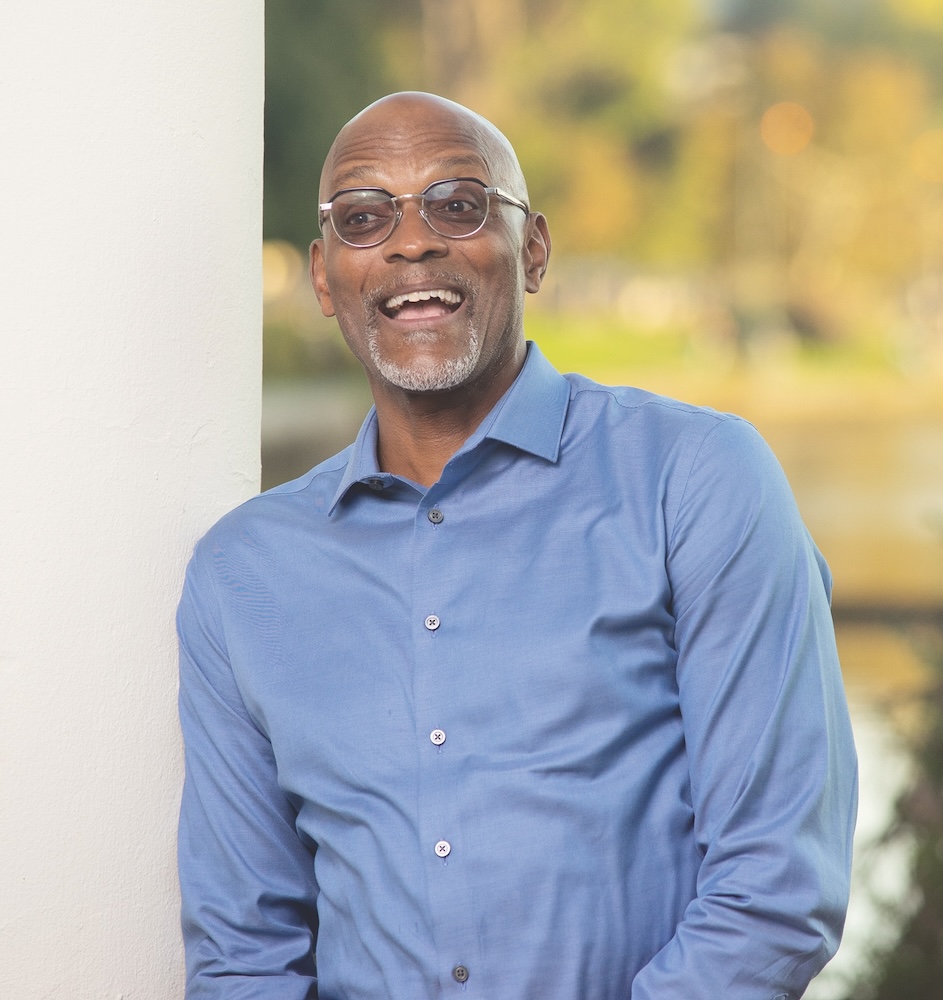Greg Hodge: Relationships Take Center Stage
So, it’s no coincidence that Greg Hodge has led the Oakland-based Brotherhood of Elders Network for the better part of a decade. This intergenerational community of men of African descent advocates for African American boys in the schools, juvenile hall, and county health system. They also preserve African American culture and heritage through storytelling and “the intergenerational transfer of wisdom.”
The father of five and doting grandfather previously served on the school board in Oakland for eight years – and it’s his love of children that fuels his life’s work. The following is an abridged Q&A with Greg Hodge.
Q: You were born and raised in Arkansas, and you went to college at Northwestern. How did you find your way to Oakland and become involved philanthropically in the East Bay community?
Greg Hodge: I went to law school here. I practiced law, did civil trial practice for the first seven or eight years out of law school, and then moved into policy advocacy in part because of what I was seeing in the court system. A lot of times while I was waiting for the civil calendar to be called, I was hearing the criminal calendar being called and in courts, you’re seeing this parade of Black and Brown men coming through the courts, mostly white DA’s (District Attorneys), mostly white public defenders, mostly white judges – with some exceptions. It bothered me to see these men who looked like me coming through that system.
And so [while] in law school, I met a woman [attorney] named Angela Glover Blackwell, one of my mentors. Angela has been in philanthropy. She started an organization called Policy Link, but back then she had an organization called Urban Strategies Council, and I had an informational interview with her. She said, “Hey, I don’t have anything right now but call me back in six months.” And we went on like this for about a year and a half and finally she said, “There’s a project I have researching the status of boys, Black boys in the United States. The consultant who started this project can’t finish it. Could you finish this work?”
And that put me into the mix of talking to people like [urban education pioneer] Geoffrey Canada in New York, folks in Chicago who were doing work, folks in Little Rock who were doing work and it just brought in a certain understanding I had about the national nature of the dynamics that I was seeing right here in Alameda County in the court system.
And so that was kind of what got me onto my path in terms of being a policy advocate, being someone who cares about violence prevention and crime prevention generally, and then more holistically, sort of community building and community development, like how can we create opportunities in education and housing and careers for African American kids in particular and Black boys specifically.
Q: What is the common theme or themes behind your philanthropic passions?

A: Probably just a basic love for children. I’ve always enjoyed working with kids. Both my parents were public school teachers, and my mom was a principal for half of her career – 42 years. My dad was a music teacher for 35. My very first kind of real job was at a swimming pool, I was a lifeguard, and I taught swimming classes. And I remember having a man who was a dentist in my hometown say that I had taught his kids to swim, and that was one of the most important things that anybody could do… I have five children of my own. I like talking to young people. I think they like talking to me. I’m a granddad now. There’s no greater joy for me than talking to my three-year-old granddaughter.
Q: In your opinion, what are the most pressing social issues in the East Bay and how can philanthropy best step up to address them?
A: I think housing is a serious issue in the East Bay, [as are] economic mobility and safety, and I think those three things are inextricably bound because if you have decent housing, if you have a meaningful job, if you are in a safe space, then your life is more than likely going to be a good life.
I look around Alameda County, as well as the city and county of San Francisco, and the numbers of people who are unhoused are frankly, in my opinion – immoral. In one of the richest regions, in the richest state, in the richest country in the world, there’s no reason for anybody to be living on the streets in squalor… It’s why I’ve run for office in the last couple years. I ran for mayor unsuccessfully two years ago. I ran for [Alameda] County Board of Supervisors because I just feel like I’m the kind of person that doesn’t like to complain if I can try to do something about it.
[It’s also] economic mobility and being able to close the wealth gap. If you look at disposable income for the average African American family, it is something like $12,000 – for the average white family in America, it’s $100,000 – so if you have an emergency, if you have a kid who’s sick, if you’ve got something that you’ve got to take care of, you’ve got to borrow money, go into debt to even address the basic stuff.
And then I think about the sense of safety and security in one’s person and in one’s home, whether it’s a woman who is dealing with domestic violence, or for that matter, a man, if you’re a kid on the streets of Oakland who’s got to worry about, you know, you go out to a sideshow and now people are firing weapons, or a festival at the lake, or Juneteenth, or any of these kind of public events, you’ve got to be kind of worried about your physical safety and if you’re going to make it home or not. Not to mention state sponsored violence and the overreach of law enforcement at times.
Q: So how can philanthropy best step up to address these three issues?
A: I think that making major, multi-year investments in those things and then allowing community actors, people who actually understand the issues because they live those issues [to execute them]. If investments are made in that way, if it’s trust-based philanthropy, not a whole set of unreasonable outcomes and impacts that often philanthropy asks people to do, things that are unreasonable, given the amount of money and/or time that these problems have been with us, then philanthropy is moving in the right direction from charity to transformative investments, from ways of being sort of controlling in terms of what philanthropy wants to see versus what a community wants to see.
When we think about philanthropy, we generally think about foundations, but individuals like myself and others, we are philanthropists if you put money into a community for meaningful things. I grew up in an African American church, and the church taught me how to give. My first giving was putting my little coins in the collection plate at church… You start to think about something greater than yourself and the needs that other people have.
And when I graduated from high school, there was a woman who was a long-time member at the church I grew up in. It was after church as I was leaving to go to college and she handed me a church lady handkerchief that had coins in it and it was tied into a little bundle. She said, “This is your ‘just-in-case’ money, just in case you need to make a phone call or just in case you need to buy a sandwich. Know that I’m giving you this because you’re taking a part of us with you.” I get emotional every time I tell that story because that was the kind of person that I grew up around. That was the kind of person that was always doing something in our community.
Q: Much has been said about the power of the “big fix,” about dreaming big and large donations or large philanthropic support towards a social issue, but less has been said about the power of smaller donations, the importance of “doing the least.” Can you speak to that?
A: I think both are important. I think that the big, hairy, audacious goal that has to be addressed around housing is going to require a regional big fix, like we don’t get to the number of units of housing, because right now, on any given day just in Alameda County, we have 6,000 people who are unhoused. And when I talk to housing advocates, they will say, “Well, the minute you find one person a house, you’ve got another person coming into the stream, right?” And so that’s going to require a big infusion of resources to interrupt and disrupt that pattern or that cycle.
On the other hand, those small, individual gifts to people matter. It’s more than the investment or the gift itself. It’s something about the heart. It’s something about the way that affects somebody. When you do a small kindness, it has a big, oversized impact in my opinion. It’s not either or. I think you do both things, and you encourage both things. And you know, it’s sort of like, if you’re a billionaire, you give a $100 million gift, right? If you’re a middle-class working person or a working-class person, you give 50 bucks.
Q: If you’re hosting a small dinner party and inviting two or three noted Bay Area philanthropists currently making an impact, who would you have over for your get together and why?
A: That’s such a great question. I think it would be [the San Francisco Foundation’s] Fred Blackwell and/or his mom [Angela Glover Blackwell] because both are important. Their whole family is important to me so I’ve gotten to know them. The “why” for them is because they’re super smart people, they really care about things, and they’re great thinkers. They think big.
I would probably invite – he doesn’t live in the Bay Area, but he has an office here – Dr. Bob Ross [formerly of] the California Endowment. He and I have gotten to be friends. Bob is one of my favorite people in the world. He just retired from the California Endowment.
If I can invite my [late] neighbor who lived to be 100 and she passed away three years ago – if there was some kind of magical way, I can invite Sarah Tramble because she was one of the most giving people I’ve ever met, I would have her over for dinner and we would have a great conversation. When she was 92, she had a heart attack, and they took her to hospital. She flatlined and they brought her back and about when she was 94… I asked her, “Miss Tramble, you died basically. Why did you come back? What did you have left to do?” And without hesitation, she says, “So that I could be standing here right now talking to you.”
